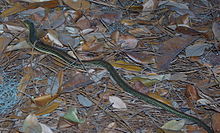Anguinae
| Anguinae Temporal range:
| |
|---|---|

| |
| An eastern glass lizard (Ophisaurus ventralis). | |
| Scientific classification | |
| Domain: | Eukaryota |
| Kingdom: | Animalia |
| Phylum: | Chordata |
| Class: | Reptilia |
| Order: | Squamata |
| Family: | Anguidae |
| Subfamily: | Anguinae |
| Genera | |
Anguinae is a subfamily of legless lizards in the family Anguidae, commonly called glass lizards, glass snakes or slow worms. The first two names come from the fact their tails easily break or snap off. Members of Anguinae are native to North America, Europe, Asia, and North Africa.
History
They first appeared in Europe during the early Eocene, around 48–49 million years ago,[citation needed] originating from North American ancestors that crossed over from Greenland via Thule Land Bridge and spread toward Asia sometime after the drying of the Turgai Strait at the beginning of the Oligocene, and then across the Bering Land Bridge to North America during the Miocene.[1] They are believed not to be monophyletic.[2]
Description
Very vestigial hindlegs are present in Hyalosaurus and Pseudopus, but are entirely absent in the other genera.[1] Members of the group largely feed on insects and other invertebrates.[3] The largest living species, the Sheltopusik (Pseudopus apodus),[4] can reach lengths of 120 centimetres (47 in).[5]
Taxonomy
The subfamily contains the following genera:
- Dopasia (7 species), native to eastern Asia
- Hyalosaurus (1 species), native to North Africa
- Ophisaurus (6 species), native to eastern North America
- Pseudopus (1 extant species, the Sheltopusik), native to Europe and Asia
- Anguis - slowworms (5 species), native to Europe and Western Asia
References
- ^ a b Lavin, & Girman, D. J. (2019). Phylogenetic relationships and divergence dating in the Glass Lizards (Anguinae). Molecular Phylogenetics and Evolution., 133, 128–140.
- ^ Klembara, Jozef; Hain, Miroslav; Dobiašová, Karolína (2014-01-31). "Comparative Anatomy of the Lower Jaw and Dentition of Pseudopus apodus and the Interrelationships of Species of Subfamily Anguinae (Anguimorpha, Anguidae)". The Anatomical Record. 297 (3): 516–544. doi:10.1002/ar.22854. ISSN 1932-8486. PMID 24482318.
- ^ "Anguidae". Animal Diversity Web. Retrieved 2017-05-02.
- ^ Lambertz, Markus; Arenz, Nils; Grommes, Kristina (2018-04-05). "Variability in pulmonary reduction and asymmetry in a serpentiform lizard: The sheltopusik, Pseudopus apodus (Pallas, 1775)". Vertebrate Zoology. 68 (1): 21–26. doi:10.3897/vz.68.e32216. ISSN 2625-8498.
- ^ Glavaš, Olga Jovanović; Počanić, Paula; Lovrić, Vanja; Derežanin, Lorena; Tadić, Zoran; Lisičić, Duje (2020-03-01). "Morphological and ecological divergence in two populations of European glass lizard, Pseudopus apodus (Squamata: Anguidae)". Zoological Research. 41 (2): 172–181. doi:10.24272/j.issn.2095-8137.2020.025. ISSN 2095-8137. PMC 7109015. PMID 32125102.
